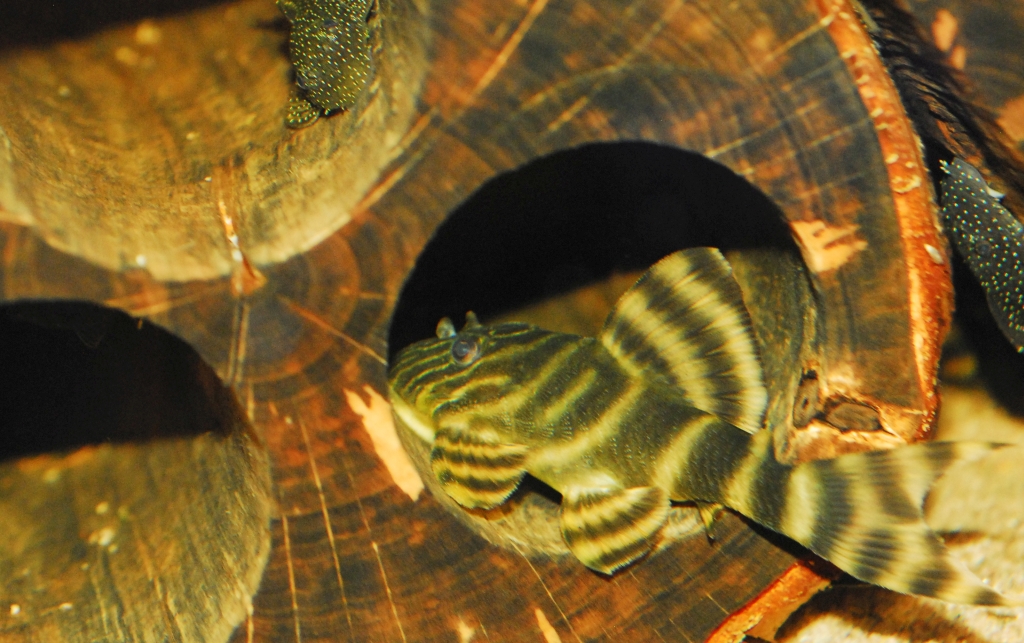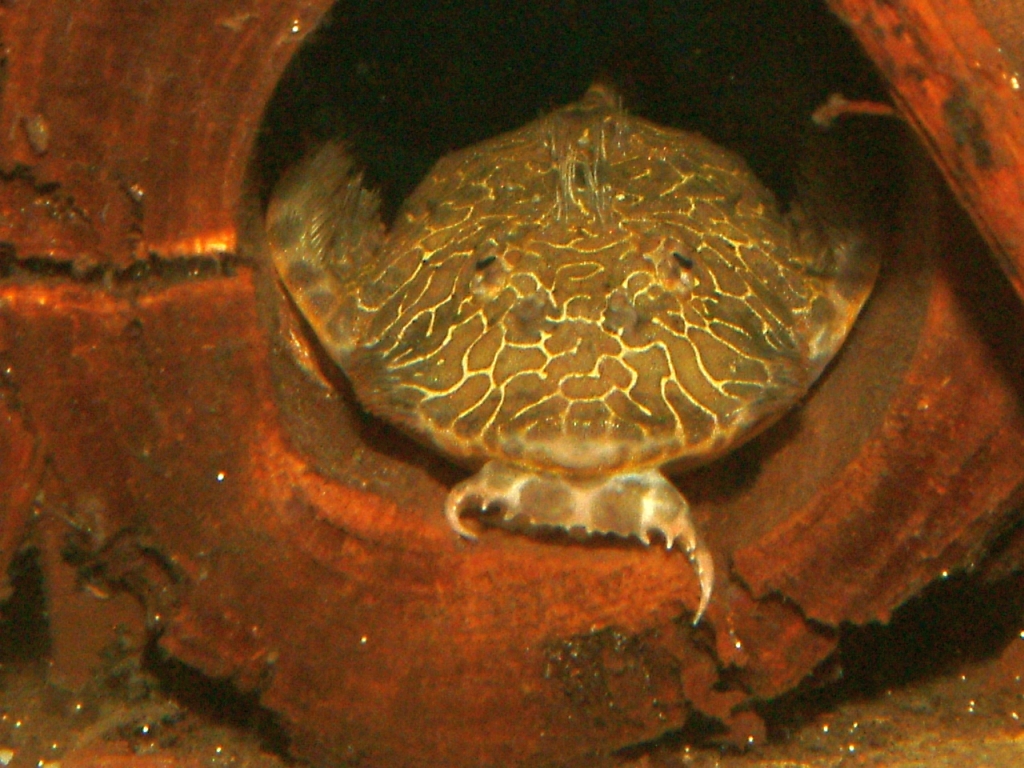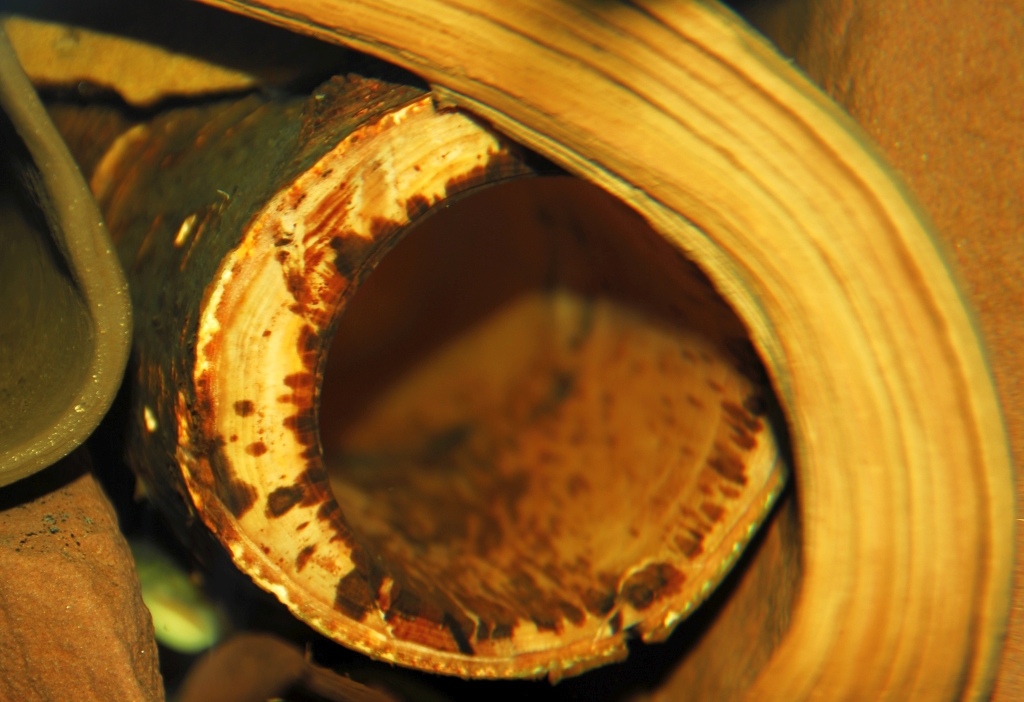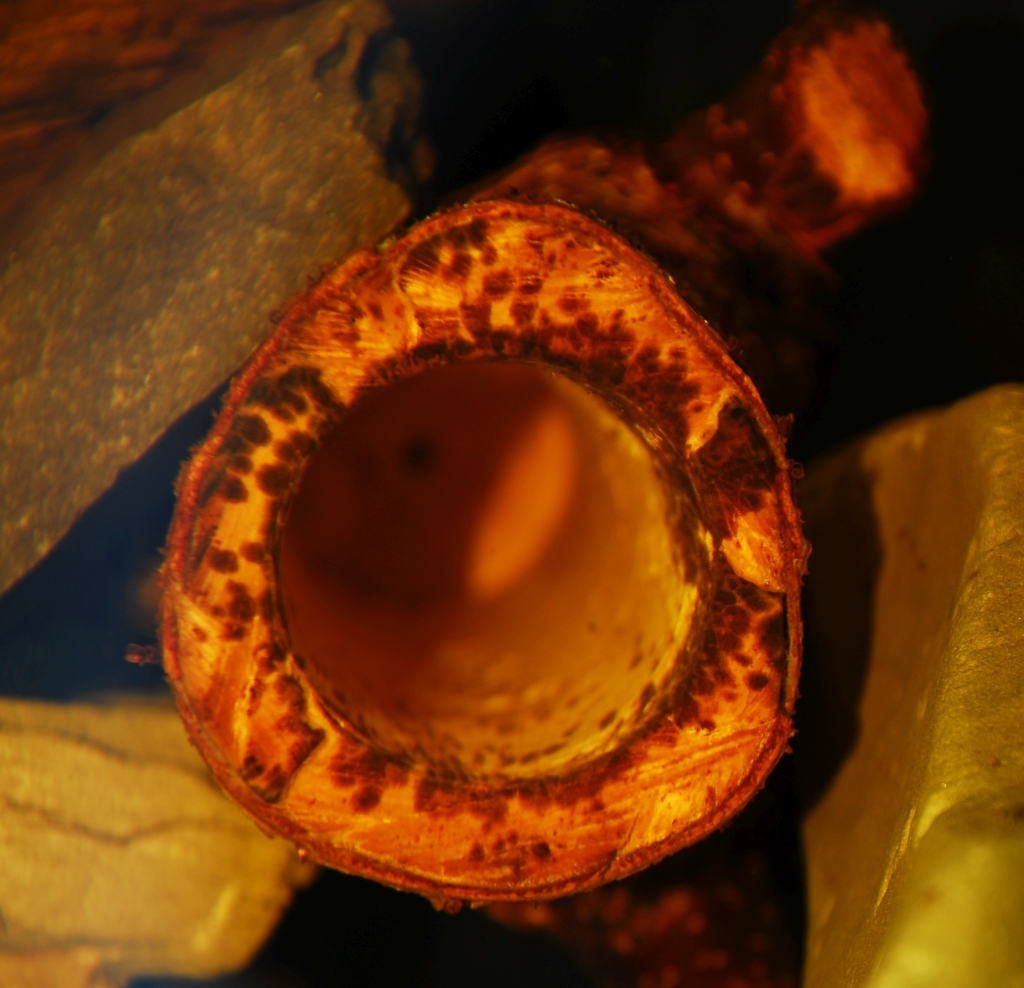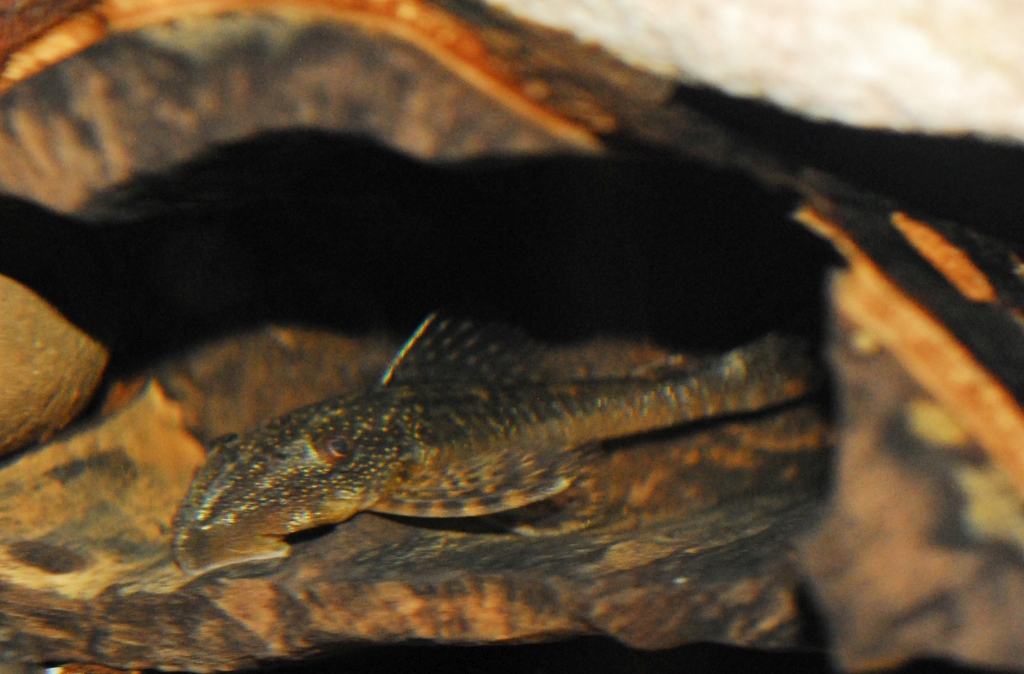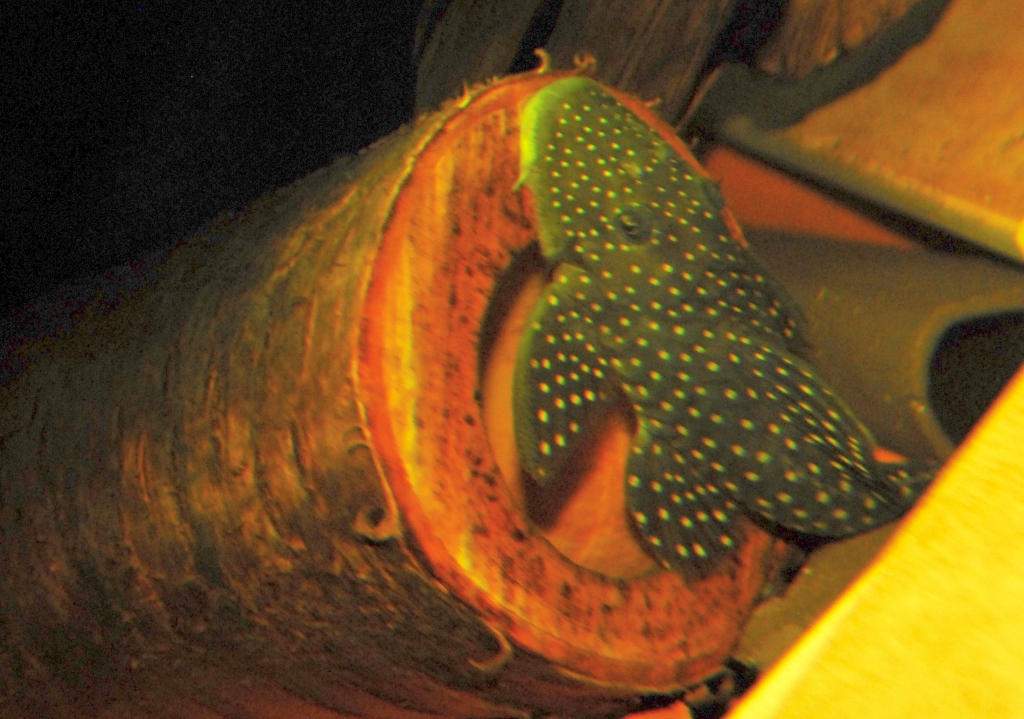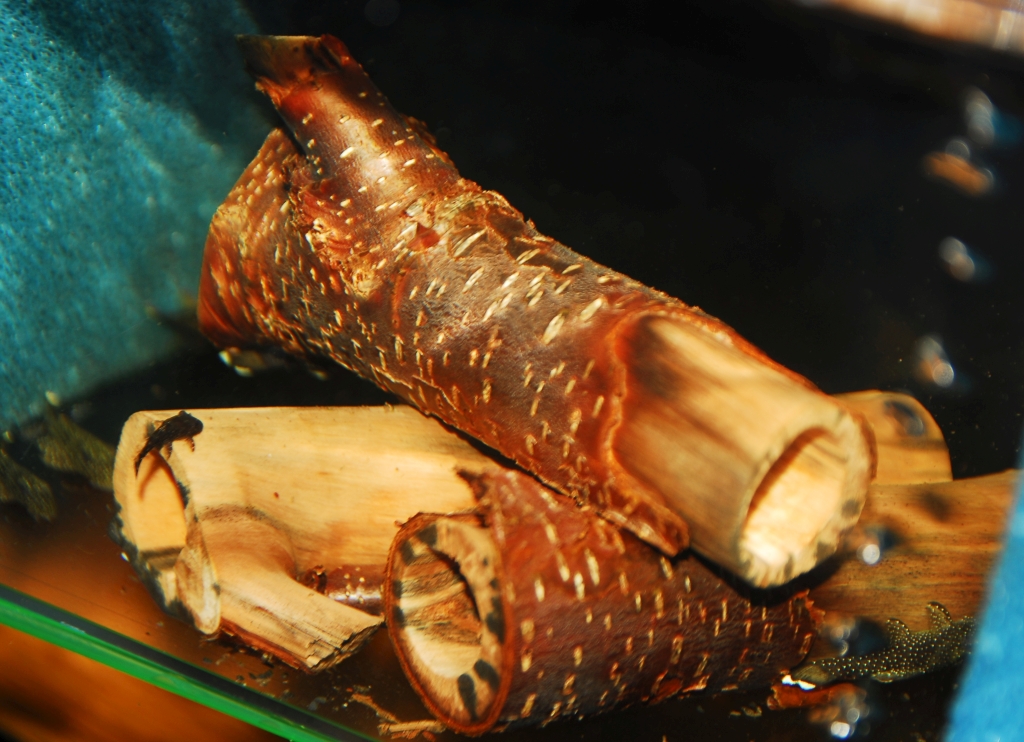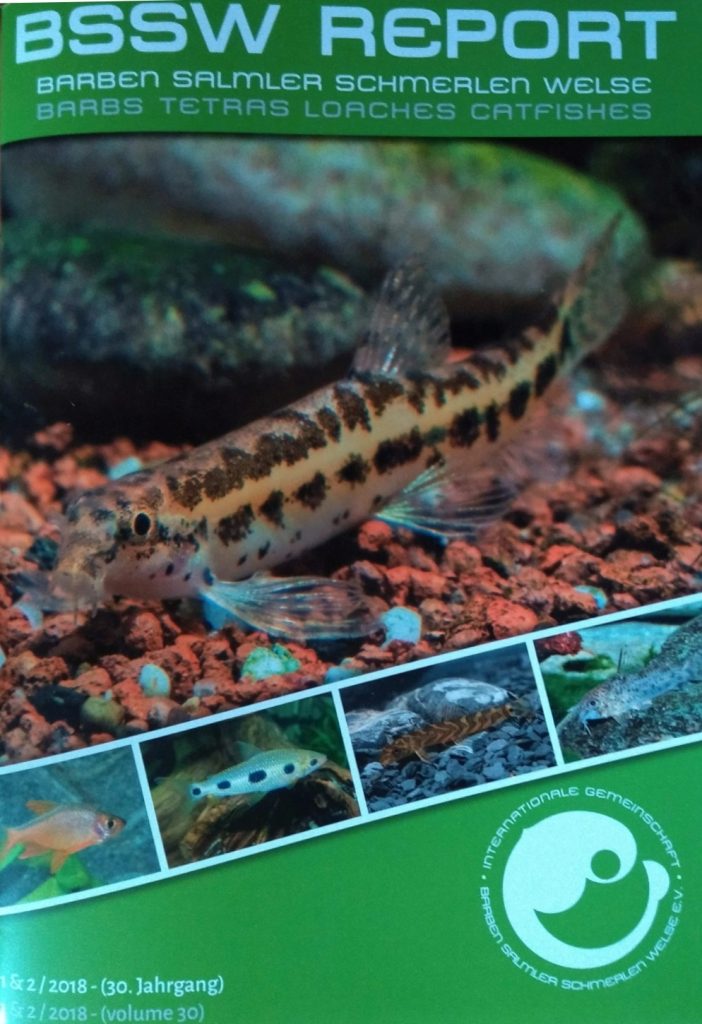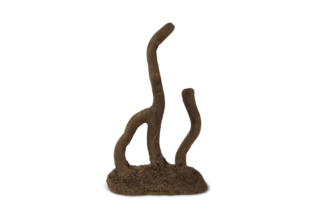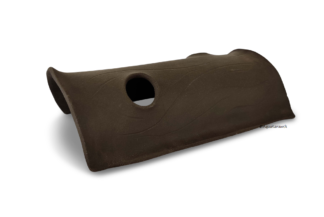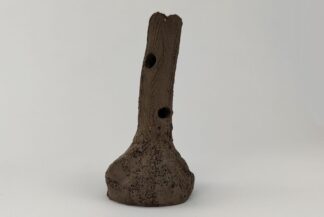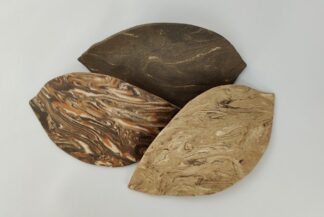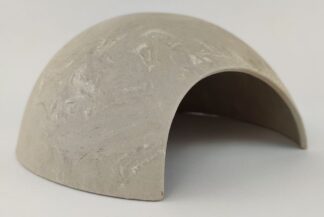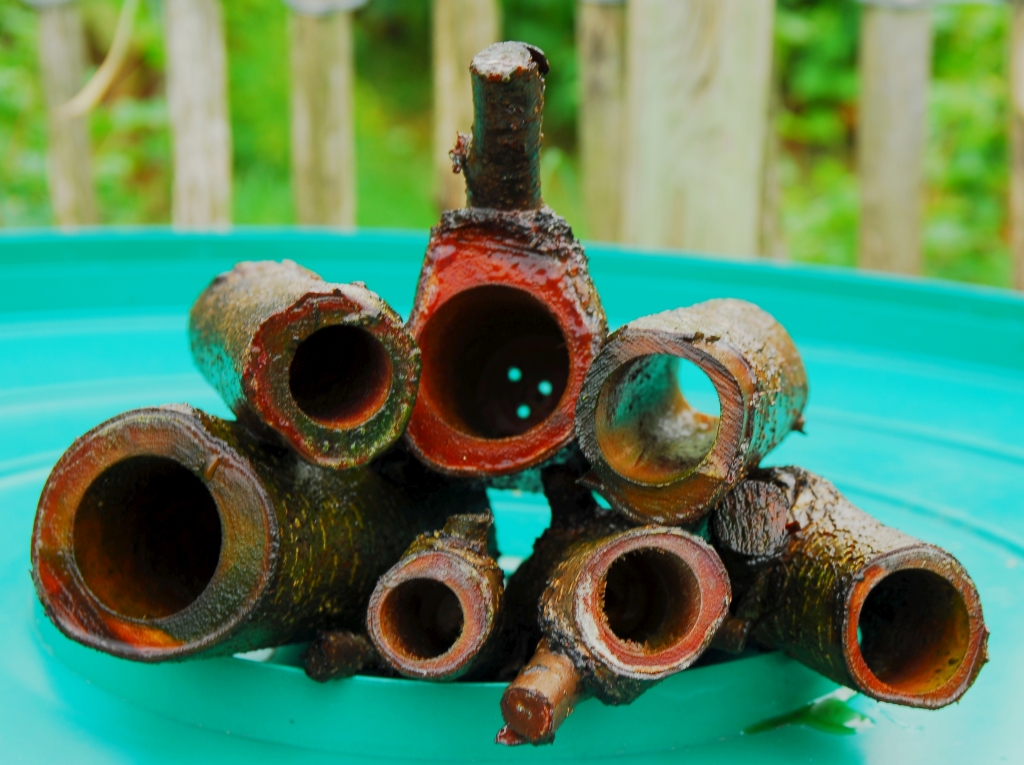
Fig. 1: A typical “wood eater” in an alder wood cave (40 mm), Panaqolus tankei (L398)
Caves as places to hide or spawn are an essential basis for the wellbeing of many groups of fish in aquaristics. Nowadays the market is dominated by clay products, since clay can be shaped into virtually any shape of any size as well as many decorative objects in addition to being completely chemically inert and not leaking any toxic products into the water when manufactured correctly (high burning temperatures). But even caves from natural materials are well-established, from simple coconut shells, bamboo tubing to bogwood caves, which we have first presented on a fair in Friedrichshafen in 2006. By now one can even sometimes find caves drilled into fresh wood on offer. Daniel Konn-Vetterlein (2012) even published an instruction manual on how to make wooden caves easily without elaborate usage of machinery.
Fig. 2: Hemiloricaria teffeana male in a continuous bogwood cave.
However, one struggles to find concrete answers to questions like these: are caves made from fresh wood save to use and what kind of advantages and disadvantages can be expected? Thus, I have experimented with different kinds of wooden caves during the last couple months in order to discuss the topic based on my findings.
Fig. 3: Cherry wood cave with a depth of 23 cm and a diameter of 75 mm.
Since wood is not all the same, the correct kind of wood has to be found. Konn-Vetterlein (2012) correctly detailed that based on the toughness some woods are difficult to work with (oak, beech and most fruit-bearing trees) while others can secrete resin (coniferous woods) whose impact on the aquarium can be hardly estimated. My experiments were executed with what I could collect in fitting sizes from my own garden, mainly fruit-bearing trees (cherry, peach) and the native broadleaved trees birch and alder. If multiple caves are to be produced a fitting method is needed in order to carve the typical catfish caves into the trunk.
Fig. 4: Alder wood cave featuring a diameter of 50 mm (approximately 20 cm length); the slight brown color of the water is due to the humins in the wood. Two caves change the water color of a 300 l tank in one week so that the back can hardly be seen. The cave must be fixated properly with stones due to the low specific weight.
Simply drilling with a wide drill into the wood might work for small holes for shrimps, but the larger diameters needed for a multitude of typical L-numbers cannot be produced in this manner. Previously I used specific augers and a very powerful drill on my bogwood caves. But since the power of the nearly uncontrollable recoil have left me with more than one bruise and severe sprain a clear warning must be issued. Thus, for my latest trials I had a standing drill retrofitted, and now I drill with augers and centre bits. Still, excellent materials as well as a heap of experience are necessary, especially with larger diameters.
Fig. 5: Lasiancistrus tentaculatus (L92) in a planar alder wood cave.
But what about the performance of the caves in the aquarium? The first thing to note: the buggers stay afloat, at least in the beginning (for instance fresh alder wood needs a couple of days if not weeks to sink). Dried wood simply has a lower density compared to water and needs to soak up a lot of it in order to sink permanently. The low specific weight of wood submersed in water is definitely a disadvantage, especially when using bigger caves for species like Pseudacanthicus or similar big L-numbers. The caves are simply not heavy enough (unlike a clay cave) and the fish can easily wear it for a swim, when not properly fixated.
Fig. 6: Alder wood caves with different diameters (20-50 mm) and different builds (closed and continuous) that had been pre –conditioned in a pond for about 4 weeks. Holes should be added at the end of the closed caves for ventilation purposes (see middle cave, top).
Another disadvantage might be the fact that fresh alder wood, for example, changes the water color just like bogwood or tropical almond leaves would, to a tea like degree. Depending on the amount of wood per volume of water one can get real “blackwater” a characteristic of the many humins present in fresh wood, not always to the liking of the owner, whereas… most fish probably enjoy it. The following must be, however, put into consideration: fresh wood is subject to a higher degree of decay in water than in dry air. Large amounts of oxygen are needed for these processes which are taken from the surrounding water, and compared to e.g. bogwood (whose decay is largely over due to thousands of years in swamps and has been downright conserved) in a considerable dimension. Since these processes also happen on the inside of the cave, I highly recommend drilling small holes into the back wall to facilitate a better water (oxygen) exchange.
Fig. 7: Pseudancistrus sp. L259 at a cherry wood cave.
Only disadvantages, thus far? Why should I even use a wooden cave then? Well, what is the situation like in natural waters? They are full of wood, offering not only an essential habitat for many species but also an important source of food. And I am not only talking about the species which cannot survive prolonged periods of time without wood, like Panaqolus, Panaque or Hypostomus, the species titled as classic “wood eaters”. Important for comprehension is the fact that scientifical studies clarified, these species do not eat the wood, rather the biofilm on top (z.B. German & Bittong 2009). This biofilm is composed of a mix of mould, algae, various protists, and bacteria which utilize the carbon of the wood as a nutrient for growth. Not only for the classic “wood eaters”, but for many other species especially their young this biofilm is essential, and it just grows so much faster and bigger on fresh wood compared to for instance bogwood. Thus, putting a cave out of fresh wood into our aquarium adds a great hiding spot as well as a great source of food. However, this also poses a potential threat if there are no or not enough organisms to continuously feed on the biofilm (snails, shrimps or most L-numbers) the high activity and growth can quickly deplete the waters oxygen.
Fig. 8: Small alder wood caves in a free floating beeding box produce a biofilm constantly available for young fish (here: Ancistrus sp. “Rio Tapajos”).
Now, could or should one use fresh wood in the aquarium? Definitely, since nothing is more decorative and beautiful than a fresh piece of wood, be it with or without a cave. However it should be added in moderation, especially when the continued usage of the biofilm cannot be guaranteed by the inhabitants. Though for fish using the biofilm as a means of nourishment, nothing compares to fresh wood. Add in a little hideaway or cavern for spawning and you have a perfect addition to your aquarium!
Alder wood caves are of course available in our shop (the category will be extended bit by bit)
References
German, D. P., Bittong, R. A., 2009. Digestive enzyme activities and gastrointestinal fermentation in wood-eating catfishes. Journal of Comparative Physiology – B, 179, 1025-1042.
Konn-Vetterlein, D. (2012): Wasserdicht – Holzhöhlen sind schnell gemacht. Die Aquarien- u. Terrarien-Zeitschrift (DATZ), 65(6): 80
after: BSSW-Report 30(1&2) – 2018

